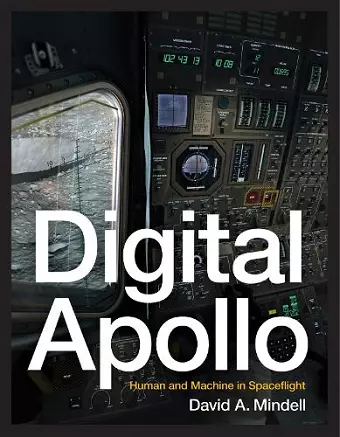Digital Apollo
Human and Machine in Spaceflight
Format:Paperback
Publisher:MIT Press Ltd
Published:30th Sep '11
Should be back in stock very soon

Digital Apollo is an excellent and unique historical account of the lengthy, and often pitched struggle of designers, engineers, and pilots to successfully integrate man and complex computer systems for the Apollo lunar landings. It brings back fond memories. -- Edgar Mitchell, Sc.D.; Captain, USN (retired) Lunar Module Pilot, Apollo 14 Mindell's well-written book deals with a terribly important and often overlooked aspect of space age technology. Commentators often present space exploration in the form of a two-sided debate, where advocates of robotics confront advocates of human flight. As Mindell adroitly demonstrates, the engineers who designed the spacecraft that actually flew to the Moon created by necessity a third position, fashioning a practical solution that stood in between the astronaut as automaton and the astronaut as a pilot fully in control. This is a 'must read' book for anyone seriously interested in understanding how space flight really works. -- Howard E. McCurdy, author of Faster, Better, Cheaper David Mindell's very important and accessible book precisely dissects Apollo history, proving Apollo a harbinger of our current digital era. -- Charles Simonyi, President and CEO, Intentional Software, and Participant, Soyuz TMA-10 Mission to the International Space Station, April 2007 Digital Apollo takes the reader on a wild ride following the impact of the increasingly complex world of data processing, control, and display on space flight. The book traces the evolution of man's role aboard high speed aircraft, the hybrid X-15, and ultimately space flight, and the lunar landing. This book is fascinating history and an important resource for future space explorers. -- Robert C. Seamans, Jr., Former Deputy Administrator, NASA
How human pilots and automated systems worked together to achieve the ultimate in flight—the lunar landings of NASA's Apollo program.
How human pilots and automated systems worked together to achieve the ultimate in flight—the lunar landings of NASA's Apollo program.
As Apollo 11's Lunar Module descended toward the moon under automatic control, a program alarm in the guidance computer's software nearly caused a mission abort. Neil Armstrong responded by switching off the automatic mode and taking direct control. He stopped monitoring the computer and began flying the spacecraft, relying on skill to land it and earning praise for a triumph of human over machine. In Digital Apollo, engineer-historian David Mindell takes this famous moment as a starting point for an exploration of the relationship between humans and computers in the Apollo program. In each of the six Apollo landings, the astronaut in command seized control from the computer and landed with his hand on the stick. Mindell recounts the story of astronauts' desire to control their spacecraft in parallel with the history of the Apollo Guidance Computer. From the early days of aviation through the birth of spaceflight, test pilots and astronauts sought to be more than "spam in a can" despite the automatic controls, digital computers, and software developed by engineers.
Digital Apollo examines the design and execution of each of the six Apollo moon landings, drawing on transcripts and data telemetry from the flights, astronaut interviews, and NASA's extensive archives. Mindell's exploration of how human pilots and automated systems worked together to achieve the ultimate in flight—a lunar landing—traces and reframes the debate over the future of humans and automation in space. The results have implications for any venture in which human roles seem threatened by automated systems, whether it is the work at our desktops or the future of exploration.
[A] wealth of research that even the most informed space fans can enjoy. Mindell avoids the temptation to glorify the space program, instead dealing with the nitty gritty logistics involved in getting a man to the moon. Digital Apollo succeeds in providing an inside track to one of the most difficult technological challenges of the 20th century.
-- James Thorne * coolhunting.com *Mindell joyfully plumbs the deep history of Apollo's decade-long clash between the MIT eggheads who built the computers and the thrill-jockey military test pilots who used them.
* IEEE Spectrum *The book is a refreshing reminder that it is still possible to uncover new stories about the early years of the American space program.
-- Dwayne A. Day * Air & Space- Winner of Winner, 2008 Eugene M. Emme Astronautical Literature Award, given by the American Astronautical Society 2008
- Winner of Winner, 2008 Eugene M. Emme Astronautical Literature Award, given by the American Astronautical Society 2008
ISBN: 9780262516105
Dimensions: 229mm x 178mm x 22mm
Weight: 748g
376 pages